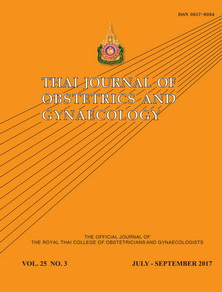Comparison of Triglyceride Level between 24-28 week’s Gestation of Nondiabetic Women with and without Positive Diabetic Screening
Main Article Content
Abstract
Objectives: To determine the difference in triglyceride levels (TG) between normal and abnormal glucose screening test but not diagnosed GDM in pregnant women.
Materials and Methods: A prospective cohort study was conducted in 108 singleton pregnant women undergoing 50g glucose challenge test (50g GCT) at 24 to 28 weeks of gestation during June to November 2015. Eighty four in control group had normal 50g GCT and twenty four subjects with abnormal 50g GCT but negative on diagnostic test [100g oral glucose tolerance test (OGTT)] in study group. The TG and fasting blood sugar (FBS) were collected in both groups after 50g GCT for one week. Hypertriglyceridemia was defined as triglyceride level of 75th percentile or greater. The Receiver Operator Characteristic (ROC) curve was constructed to look for the cut-off level of TG which provide the best sensitivity and specificity of large for gestational age (LGA).
Results: There was no significant difference in TG which was 188 and 189 mg/dl in control and study group respectively (p = 0.402). Hypertriglyceridemia was 237 mg/dl or greater. Incidence of hypertriglyceridemia was not different between groups (p = 0.508). The percentage of LGA in the study group was 29.2% while in the control group was 9.5% (p = 0.039). Using the cut-off TG > 183.5 mg/dl has a sensitivity of 60% and specificity of 44% for LGA detection.
Conclusion: TG was not different between pregnant women with normal 50g GCT and those who had abnormal 50g GCT but negative on diagnostic test. The TG was not good indicator for LGA detection.
Article Details
References
2. Battaglia C, Lubchenco O. A practical classification of newborn infants by weight and gestational age. J Pediatr 1967;71:159-63.
3. Lubchenco O, Hansman C, Boyd E. Intrauterine growth in length and head circumference as estimated from live births at gestational ages from 26 to 42 weeks. J Pediatr 1966;37:403-8.
4. Lu Y, Zhang J, Lu X, Xi W, Li Z. Secular trends of macrosomia in southeast China 1994-2005. BMC Public Health 2011;11:818.
5. Bao C, Zhou Y, Jiang L, Sun C, Wang F, Xia W, et al. Reasons for the increasing incidence of macrosomia in Harbin, China. BJOG 2011;118:93-8.
6. Abramowicz S. Fetal macrosomia [Internet]. 2015 [cited 26/5/2015]. Available from: http://www.uptodate.com/contents/fetal-macrosomia.
7. Weissmann A, Simchen J, Zilberberg E, Kalter A, Weisz B, Achiron R, et al. Maternal and neonatal outcomes of large for gestational age pregnancies. Acta Obstet Gynecol Scand 2012;91:844-9.
8. Lee M, Kim J, Kim Y, Han Y, Ahn K, Choi S, et al. Gestational weight gain is an important risk factor for excessive fetal growth. Obstet Gynecol 2014;57: 442-7.
9. Ferraro M, Barrowman N, Prud’homme D, Walker M, Wen SW, Rodger M, et al. Excessive gestational weight gain predicts large for gestational age neonates independent of maternal body mass index. J Matern Fetal Neonat Med 2012;25:538-42.
10. Catalano M, Kirwan P, Haugel-de Mouzon S, King J. Gestational diabetes and insulin resistance: role in short- and long-term implications for mother and fetus. Am J Clin Nutr 2003;133.
11. Olmos R, Rigotti A, Busso D, Berkowitz L, Santos L, Borzone R, et al. Maternal hypertriglyceridemia: A link between maternal overweight-obesity and macrosomia in gestational diabetes. Obesity 2014;22:2156-63.
12. Vambergue A, Valat S, Dufour P, Cazaubiel M, Fontaine P, Puech F. Pathophysiology of gestational diabetes. Eur J Gynecol Obstet Biol Reprod 2002;31:3-10.
13. Cunningham G, Leveno J, Bloom L, Spong Y, Dashe S, Hoffman L, et al. William obstetrics. 24thed. New York: McGraw-Hill Education; 2014.
14. Barrett L, Dekker M, McIntyre D, Callaway K. Normalizing metabolism in diabetic pregnancy: is it time to target lipids? Diabetes Care 2014;37:1484-93.
15. Hou L, Zhou H, Chen Y, Wang M, Shao J, Zhao Y. Effect of maternal lipid profile, C-peptide, insulin, and HBA1c levels during late pregnancy on large-for-gestational age newborns. World J Pediatr 2014;10:175-81.
16. Ghio A, Bertolotto A, Resi V, Volpe L, Di Cianni G. Triglyceride metabolism in pregnancy. Clin Chem 2011;55:133-53.
17. Son H, Kwon Y, Kim H, Park W. Maternal serum triglycerides as predictive factors for large-for-gestational age newborns in women with gestational diabetes mellitus. Acta Obstet Gynecol Scand 2010;89:700-4.
18. Kitajima M, Oka S, Yasuhi I, Fukuda M, Rii Y, Ishimaru T. Maternal serum triglyceride at 24-32 weeks’ gestation and newborn weight in nondiabetic women with positive diabetic screens. Obstet Gynecol 2001;97:776-80.
19. Ryckman K, Spracklen N, Smith J, Robinson G, Saftlas F. Maternal lipid levels during pregnancy and gestational diabetes: a systematic review and meta-analysis. BJOG 2015;122:643-51.
20. Khan R, Ali K, Khan Z, Ahmad T. Lipid profile and glycosylated hemoglobin status of gestational diabetic patients and healthy pregnant women. Indian J Med Sci 2012;66:149-54.
21. Di G, Miccoli R, Volpe L, Lencioni C, Ghio A, Giovannitti MG, et al. Maternal triglyceride levels and newborn weight in pregnant women with normal glucose tolerance. Diabetes 2005;22:21-5.
22. Martin C, Siega-riz A, Robinson W, Daniels J, Perrin E, StuebeA,et al. Maternal dietary patterns are associated with lower level of cardiometabolic markers during pregnancy. Paediatr Perinat Epidemiol 2016;30:246-55.
23. Xie S, Chen T, Huang X, Chen C, Jin R, Huang Z, et al. Genetic variants associated with gestational hypertriglyceridemia and pancreatitis. Plos One 2015;10
24. Leikin EL, Jenkins JH, Pomerantz GA, Klein L. Abnormal glucose screening tests in pregnancy: a risk factor for fetal macrosomia. Obstet Gynecol 1987;69:570-3.


